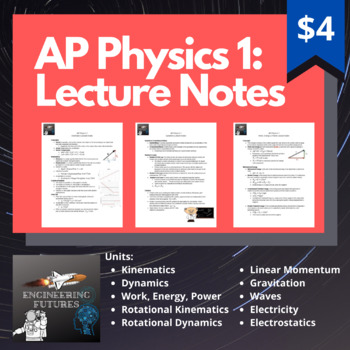AP Physics 1 Lecture Notes (Entire Year)
Engineering Futures
69 Followers
Grade Levels
9th - 12th, Higher Education, Adult Education, Homeschool
Subjects
Resource Type
Standards
NGSSHS-PS2-2
NGSSHS-PS2-1
NGSSHS-PS4-1
NGSSHS-PS2-4
Formats Included
- PDF
Pages
18 pages
Engineering Futures
69 Followers
What educators are saying
This was a great resource to help me structure my classes. It filled in gaps for me and my students. Thank you.
Also included in
- Looking to teach Physics online this semester? This bundle has resources that will aid in teaching Physics online!! This bundle has PowerPoints, worksheets, assessments, and numerous labs that can be conducted at home! This bundle addresses all the concepts taught in a typical high school physics clPrice $145.00Original Price $176.25Save $31.25
Description
This file contains lecture notes for the entire AP Physics 1 or General Physics course. These notes are the perfect tool for studying and reviewing for the AP Physics Exam. These notes have definitions, equations, concepts, and tips that can be used as unit handouts or studying tools for exams or quizzes.
* FOR FREE PHYSICS TUTORIALS, PLEASE SUBSCRIBE TO MY YOUTUBE CHANNEL*
Topics:
- Kinematics
- Dynamics
- Work, Energy, Power
- Rotational Kinematics
- Rotational Dynamics
- Linear Momentum
- Gravitation
- Waves
- Electricity
- Electrostatics
Total Pages
18 pages
Answer Key
N/A
Teaching Duration
N/A
Report this resource to TPT
Reported resources will be reviewed by our team. Report this resource to let us know if this resource violates TPT’s content guidelines.
Standards
to see state-specific standards (only available in the US).
NGSSHS-PS2-2
Use mathematical representations to support the claim that the total momentum of a system of objects is conserved when there is no net force on the system. Emphasis is on the quantitative conservation of momentum in interactions and the qualitative meaning of this principle. Assessment is limited to systems of two macroscopic bodies moving in one dimension.
NGSSHS-PS2-1
Analyze data to support the claim that Newton’s second law of motion describes the mathematical relationship among the net force on a macroscopic object, its mass, and its acceleration. Assessment is limited to one-dimensional motion and to macroscopic objects moving at non-relativistic speeds. Examples of data could include tables or graphs of position or velocity as a function of time for objects subject to a net unbalanced force, such as a falling object, an object sliding down a ramp, or a moving object being pulled by a constant force.
NGSSHS-PS4-1
Use mathematical representations to support a claim regarding relationships among the frequency, wavelength, and speed of waves traveling in various media. Examples of data could include electromagnetic radiation traveling in a vacuum and glass, sound waves traveling through air and water, and seismic waves traveling through the earth. Assessment is limited to algebraic relationships and describing those relationships qualitatively.
NGSSHS-PS2-4
Use mathematical representations of Newton’s Law of Gravitation and Coulomb’s Law to describe and predict the gravitational and electrostatic forces between objects. Emphasis is on both quantitative and conceptual descriptions of gravitational and electric fields. Assessment is limited to systems with two objects.





